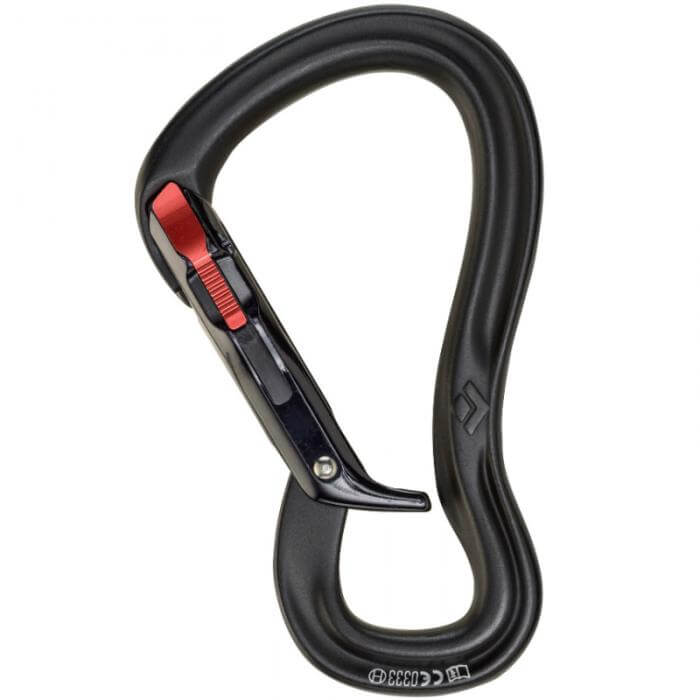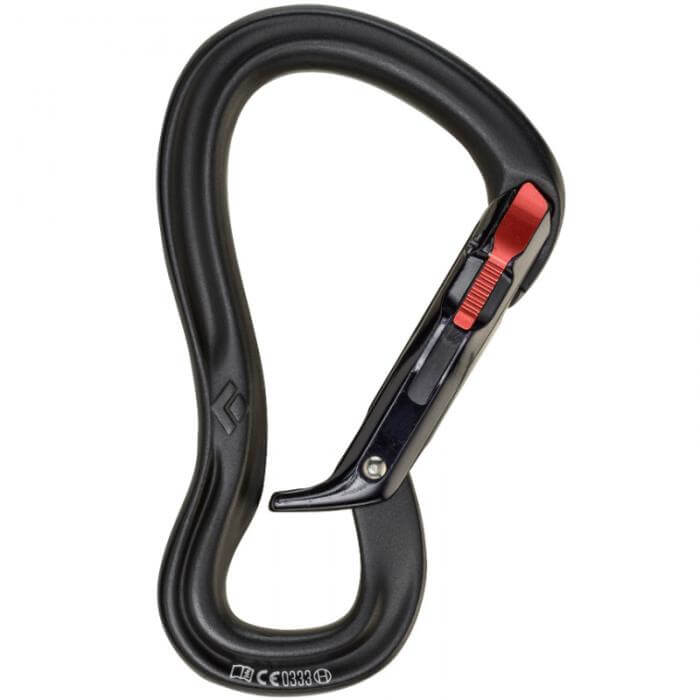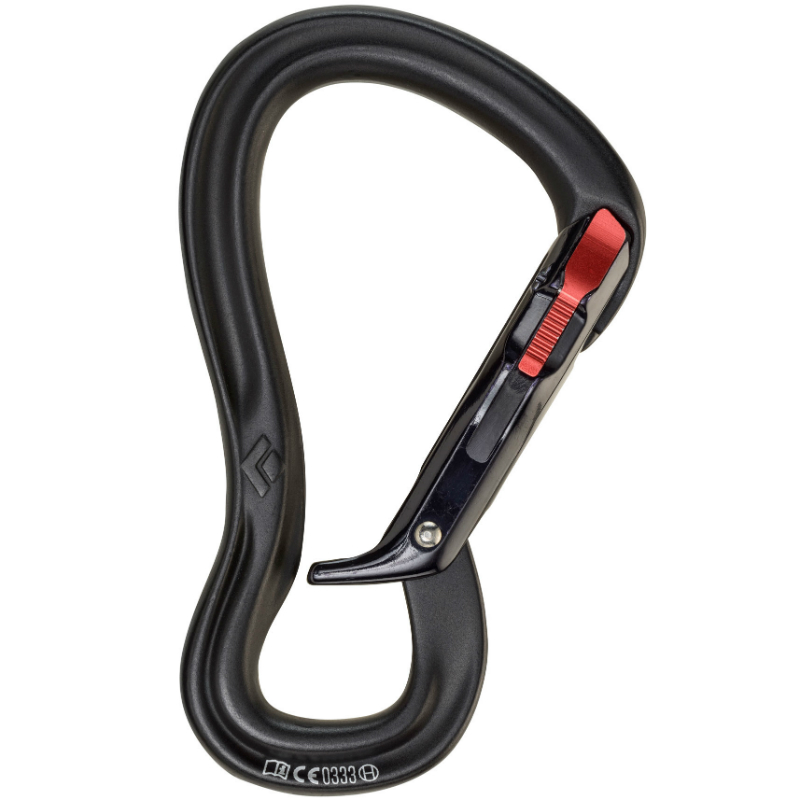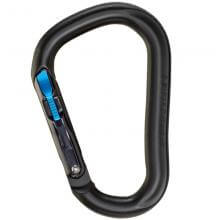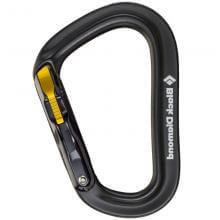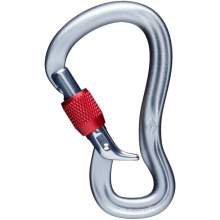GridLock Magnetron
Description
Combining maximum security and ease of use like never before, the Black Diamond Magnetron GridLock uses the power of magnets to reinvent the auto-locking carabiner. Magnetron Technology uses two magnetic arms in the gate and a steel insert in the carabiner's keylock nose to create an ultra-secure, self-clearing and redundant locking mechanism that can be easily used with either hand. Combine that with our innovative GridLock shape, which traps the belay loop to eliminate cross-loading, and the Magnetron GridLock is the ultimate belay carabiner.
Hot-forged construction
Innovative gate design uses two magnetic arms in the gate and a steel insert in the nose for super-secure, interference-free closure
Keylock nose prevents snagging
One-hand operable
Unique shape isolates belay loop to eliminate cross-loading
I-Beam spine transitions into a rounded, large rope-bearing surface
Retail price
This Product is Hard to Find.
We don’t know where you can buy this item online in the US. We’ll continue to check all the major retailers and will update this page as soon as we find one.
If you know where to find this online in the US, let us know, and we’ll add the link.

Weight (g)  Weight (g)In grams, the weight, as stated by the manufacturer/brand. |
78 g |
Shape  ShapeRule of thumbAlmost every carabiner you use will be non-locking offset D’s, with the exception of a Pear/HMS locker as your belay ‘biner. Offset D (aka Modified D)60% of the market 
A modification of the standard D shape, the top of an offset D is much wider, allowing for a larger (and superior) gate opening. When loaded, most of the weight is transferred to the spine of the carabiner making them stronger than most other shapes. Used for top and bottom quickdraws, as racking carabiners, and lightweight lockers. Pear / HMS22% of the market 
The Pear/HMS carabiner is used primarily for belaying and/or setting a powerpoint in an anchor. The wide top means they can hold a lot of gear. They are almost always locking and are generally heavier (than D/offset D's) because they need more material to gain back strength lost due to their shape. Oval8% of the market 
The first carabiner shape to be mass produced. When loaded, the pressure is shared equally on both sides of the ‘biner. Since the weaker gate shares the load with the spine, oval biners aren’t as strong as shapes that direct the load to the spine. The bonus is, your gear rests squarely in the middle, so it's great for holding nuts, pulleys, and prusiks. D (aka symmetric D)7% of the market 
D’s have a symmetrical shape that sets the rope closer to the spine, putting the load on the spine (versus sharing the load with the weaker gate side, like the oval). Since the strongest part of the carabiner carries the weight, D’s are the strongest shape. Downside: Smaller gate openings than the offset D. Quick Link (aka Oval link, Maillon Raptide)1% of the market 
Although most climbers wouldn’t refer to this shape as a “carabiner” they are certified by the same EN standard as all the other carabiners. These semi-permanent links ensure the gate will not accidentally open. They're used when setting up a semi-permanent rappel station (not used while climbing up). Semi-Circle / 3Dless than 1% of the market 
Semi-circle: Mostly used by Search and Rescue as this is a great way to secure a chest harness. Learn More
Pros and cons of each shape, graphs and more examples |
Pear / HMS |
Locking  Lockingmain non-locking carabiners uses:
main locking carabiners uses:
screw gate vs auto-locking gateScrew gates are generally lighter and cheaper. Auto-locking gates are usually considered safer as they automatically snap shut, not counting on one's memory to close and are harder to accidentally unlock. The debate comes on opening speed as some are much faster while others can be a struggle. Learn More
See the newest auto-locking gate technologies |
Auto - 2 action |
Straight or Bent  Straight or BentIt's easier to see the difference between straight and bent gates on solid gate carabiners: 
Straight GateThe standard. Always used as the bolt-end of the quickdraw, and still sometimes used on the rope-side too. Also used for racking gear such as cam and nuts. Bent GateCreated to make it easier to put the rope into a quickdraw with their larger gate opening. Primarily used on the rope-end (bottom) of quickdraws. Extra Notes
Important NoteMany manufacturers are now making the bolt-end carabiner come standard in silver (to match the bolt color), and are coloring the rope-end with other anodizations. Do not mix (interchange) bolt-end carabiners and rope-end carabiners. This can be very dangerous as small abrasions made by the bolt can easily wear your rope. DMM put out a great video/write-up on this issue. |
Straight |
Full Size  Full SizeFull size carabiners are easier to hold but generally they're also heavier. This is a totally debatable field as there is no official size, weight, or gate opening necessary to be full size. There are no certifications and this isn't a standard the manufacturer's normally describe specifically. We did our best to compare (descriptions, in-person use, etc), as a way to help give more information about this carabiner. Like always, if you see something that seems totally off, send us a note. |
Yes |
Keylock  KeylockA keylock nose means the nose is smooth. Keylock carabiners are also known as: snag-free, notch-less, and hook-less. 
Keylock BenefitThe lack of a hooked nose makes for less snagging on gear and bolts – a dramatic improvement. Keylock DrawbackGiven that they’re more complicated to manufacture, keylock designs often come at a higher price, especially in wiregates. Worth ConsideringThere are more design features necessary to guarantee a snag-free experience, like the curvature of the nose. Some keylock carabiners will still catch on the nose because of the lack of a smooth nose arc (smoother the arc, smoother the clip). Learn More
Check out our blogpost that goes over carabiner nose design to get all the details |
Yes |
Solid or Wire  Solid or Wire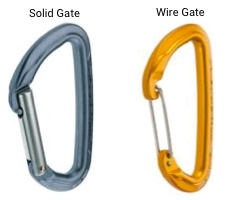
Solid GatesGenerally on beefier carabiners, so they're usually heavier and more durable. They can also feel more substantial in your hands while clipping. Often favored by sport climbers. Wire GatesFeatured on the lightest carabiners, so they're favored by trad and alpine climbers. Some considerationsIf you want keylock nose carabiners, then solid gates will be much cheaper compared to wire gates. When wiregates first came out they were not trusted (too new, looked too simple). Now, it's proven that wiregates have less gate flutter and gate shutter than solid gates. Learn More
Compare gate flutter and gate shutter |
Solid |
Gate Opening  Gate Opening (mm)Gate opening refers to the distance between a carabiner’s nose and the fully open gate. 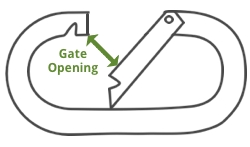
General Guidelinestop of your quickdraw: 17 mm – 22 mm Adding bias towards a larger gate opening is a great option once you’ve narrowed your choice to a few similar carabiners and need help determining which one is the best. Learn More
Gate opening comparisons, examples, averages, shape, sizes, graphs, and explanations |
21 mm |
Number of Colors  Number of ColorsThe number of different colors that you can find this carabiner in. This color-coding practice was started with just 2 colors, usually silver (that goes on the bolt side of a quickdraw) and another color for the rope side. Now, carabiners come in 5+ colors sets known as "rack packs" so your carabiners can match your cams. Climbers can also match their carabiner color to their harness or other gear just for fun. Learn MoreCarabiner Rack Packs Explained |
1 |
Lock Indicator  Visual Warning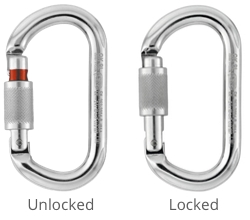
A lock indicator is a visual warning only seen on locking carabiners. It adds some sort of visual to show if the carabiner is unlocked such as the color red, a danger sign, an unlocked image, etc. When the carabiner is locked the visual indicator is hidden. Only a small list of manufacturers add this safety feature, although you can easily add one yourself with a permanent marker. |
No |
Strengths (kN)  Strengths (kN)In kilonewtons, the strength, as stated by the manufacturer/brand. Major Axis Closed Gate Strength
This is the strongest orientation and the way carabiners are designed to be loaded. Major Axis Open Gate Strength
This strength is measured because while climbing, carabiners lying against the rock can be opened slightly as they move across an uneven surface. A carabiner can also open slightly during a fall as the ‘biner starts to vibrate, dispersing the energy (also called "gate flutter"). A weak gate closure (due to a poor/failing spring or an over-stressed wire) could also leave the gate ajar. Minor Axis Gate Strength
Carabiners are not intended to be loaded along the minor axis (cross-loaded), but it is possible for a carabiner to unintentionally rotate during use, especially while belaying. Of all accidental misuses of a carabiner, cross-loading is the most frequent suspect, which is why there is a rating for it. Generally wire gates are stronger than solid gates in the minor axis. During the test, the wire gate bends, absorbing some of the force, as compared to a less pliable solid gate. Learn More
How carabiners are rated, recommendations and strengths. | |
The Black Diamond GridLock Magnetron is a belay specific carabiner designed to prevent the possibility of cross-loading when catching a fall. We have seen many wildly different designs that attempt to solve this problem, but unfortunately Black Diamond's is the most annoying to use. Manipulating the belay carabiner repeatedly is an inherent part of belaying while climbing, and since this design makes this a challenging task compared to others, it is not by any means the first one that we would recommend buying.
The Magnetron action is smooth and has a very satisfying "click" when opening. Despite my initial skepticism, the lock mechanism feels sturdy in my hand. One of my only issues with the magnet locking mechanism is that playing with it is extremely addicting. It's like clicking a pen. You will find yourself idly opening and closing the magnets constantly. This is troubling when your partner's life depends on that lock staying closed. click. click. click. click. click. click. Try not to play with it. Try. You can't.
Having used the Magnetron for several months now, I really like it and intend to stick with it. If you are looking for an auto-locking HMS the Black Diamond Magnetron Gridlock HMS is a very strong contender if not the best choice available. It is more expensive than it competitors but I think the clean, simple and effective design justifies the extra cost.
For the past couple of months Vertical Life has been out and about using Black Diamond’s shiny new RockLock Magnetron locking ‘biner (the only one in the country no less). The Magnetron is BD’s purported paradigm-busting piece of kit that does away with screw and twist-locking mechanisms in favour of magnets as a way of securing the gate of the ‘biner shut. It’s touted as removing the need to make things complicated to make them secure.
Wherever we have pulled the Magnetron out, be it at The Arapiles, in The Blueys, at The gym or around a campfire in The Gramps, people’s reactions have always followed the same trajectory: fascination makes way for wariness, which quickly builds into an attempt to identify potential points of failure, which is rendered into a brief – often heated – quasi-scientific discussion that tapers into stoney acceptance accompanied by covetous glances a la Smeagol.
At first glance, our reaction to BD’s Magnetron technology for locking carabiners was that it might be the most innovative solution we’d ever seen to a problem that might not exist. But after digging deeper and using the biners indoors and out—they won’t be available in stores until July—we’re convinced Black Diamond is onto something. Instead of the traditional screw gate or spring-loaded auto-locking mechanism, the Magnetron relies on magnets (duh!), with a steel bar embedded in the carabiner nose and magnets in two locking arms on either side. Press on the arms and the magnets’ repulsion holds them apart—and keeps the gate unlocked. Release the arms and the magnets clamp onto the nose. The magnets don’t provide the strength in the lock—the shape of the gate and nose do that. But they do make it super-easy to lock and unlock a biner with one hand (and it’s just as easy with either hand). The system is also easy to use with gloves and less likely to ice up than screw gates in winter. The Rocklock is a typical small pear locker; the Gridlock, a Climbing Editors’ Choice winner in 2011, is BD’s clever belay biner designed to prevent cross-loading. Both biners weigh about 3 oz. and pair smoothly with a Grigri 2 or tube-style belay device. These are about the most expensive aluminum carabiners on the market—$7 to $15 more than the same BD biners without the new technology, but we think you should try one for yourself. You might get hooked.
No voice, but entertaining video
Video shows how the Black Diamond carabiners are made.

